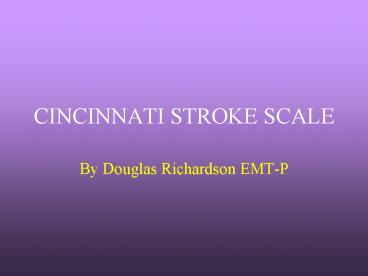CINCINNATI STROKE SCALE - PowerPoint PPT Presentation
1 / 20
Title:
CINCINNATI STROKE SCALE
Description:
CINCINNATI STROKE SCALE By Douglas Richardson EMT-P Objectives On completion of the course the student shall be able to: Describe the importance of rapid detection ... – PowerPoint PPT presentation
Number of Views:168
Avg rating:3.0/5.0
Title: CINCINNATI STROKE SCALE
1
CINCINNATI STROKE SCALE
- By Douglas Richardson EMT-P
2
Objectives
- On completion of the course the student shall be
able to - Describe the importance of rapid detection
CVA/TIA symptoms in the prehospital setting. - Describe why extensive neurological examinations
are inappropriate in the prehospital setting.
3
Objectives
- On completion of the course the student shall be
able to - Describe the three points evaluated in the
Cincinnati Stroke Scale evaluation. - Perform a Cincinnati Stroke Scale evaluation on a
victim
4
Stroke in The Prehospital Setting
- Stroke must be suspected quickly by EMTs and
paramedics in the field. - In one study EMTs and Paramedics correctly
identified stroke and TIA in 72 of the patients
with either condition. - Extensive neurological exams are impractical in
the prehospital setting
5
CINCINNATI STROKE SCALE
- Identifies patients with strokes.
- It evaluates three major physical findings.
- Facial droop
- Motor arm weakness
- Speech abnormalities
6
Facial Droop
- Have the patient show their teeth or smile.
- Normal both sides of the face move equally well
- Abnormal one side of the face does not move as
well as the other side
7
(No Transcript)
8
(No Transcript)
9
Arm Drift
- Have the patient close his/her eyes and hold both
arms out. - Normal both arms move the same way, or both
arms do not move at all. - Abnormal one arm does not move or one arm
drifts down compared to the other arm. - Other findings such as pronater grip, may be
helpful
10
(No Transcript)
11
(No Transcript)
12
Speech
- Have the patient say You cant teach an old dog
new tricks. - Normal patient uses correct words with no
slurring. - Abnormal patient slurs words, uses
inappropriate words, or is unable to speak
13
You cant teach an old dog new tricks.
14
(No Transcript)
15
Cincinnati Prehospital Stroke Scale
- Patients with 1 of these 3 findings -as a new
event - have a 72 probability of an ischemic
stroke. - If all 3 findings are present the probability of
an acute stroke is more than 85 - Immediately contact medical control and the
destination ED and provide prearrival
notification.
16
Stroke
- Once the diagnosis of stroke is suspected, time
in the field must be minimized. - The presence of a patient with acute stroke is a
load and go. - A more extensive examination or initiation of
supportive therapies should be accomplished en
route to the hospital.
17
Stroke
- One of the most important aspects of your history
must be the time of onset of the symptoms. - This time will have important implications for
potential therapy. - Early notification of the ED is essential.
- Careful assessment is a must, signs of stroke can
be very subtle.
18
Evaluation
- Describe the importance of rapid detection
CVA/TIA symptoms in the prehospital setting. - Describe why extensive neurological examinations
are inappropriate in the prehospital setting.
19
Evaluation
- Describe the three points evaluated in the
Cincinnati Stroke Scale evaluation. - Perform a Cincinnati Stroke Scale evaluation on a
victim
20
Summary
- Early detection of CVA/TIA in the prehospital
setting can have a dramatic effect of the
mortality and morbidity of patients. In depth
neurological exams are not only un-necessary in
the prehospital settings but are in fact counter
productive. Using the Cincinnati Stroke Scale an
EMT or Paramedic can quickly and accurately
access the neurological status of a patient
presenting with CVA/TIA Signs and symptoms.































